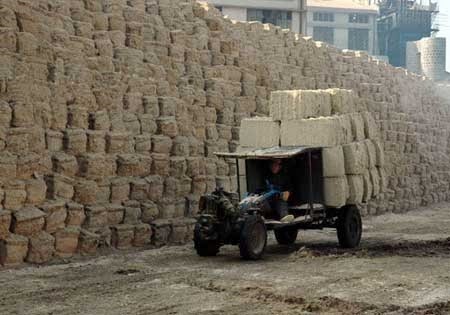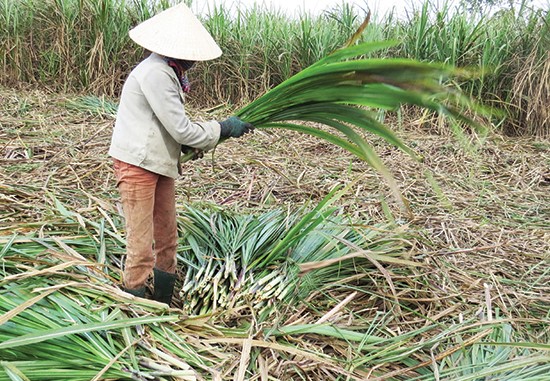In Vietnam, usually in the cold rainy season, food sources for cattle are scarce. It is necessary to understand the methods of preserving food for cattle at this time to avoid economic losses. Here are some ways to stock up on livestock feed such as bagasse silage, incubation, or drying of green feeds that have had very good results in the past.

Incubation green feed
Incubation grass is the intermediate method, between making hay and fresh grass. Grasses for wilt have higher dry matter content than for fresh incubation. Incubation wilt is usually less fermented, less nutrient lost during incubation.
The way for weed to incubation as follows: Collect the amount of grass each day, depending on the amount and moisture present, can be cooked immediately or exposed and then tempered. The humidity of the grass should be between 50% -60%, nylon or any PVC. Put the grass in layers, squeeze it, then let another layer, so that until the bag full of grass. Note as tight as possible. After filling the grass, wrap the wrapper and wrap the bag in a second nylon bag, tie it tightly, then place it away from mice or other insects. This is a decisive step if the open bag is damaged in the bag.

Reserve high fiber by-products
High fiber by-products are abundant and diverse, such as straw, sugar cane leaves and cassava tops. Principles for increasing the utilization of fiber by-products include postharvest collection for long-term storage; Replenish missing or processed nutrients to break down complex links to increase digestibility and intake. In particular, less physical and biological treatment methods are used due to the complex process, high equipment costs. When the method of chemical treatment, treated with silage, urea annealing is the method commonly used today.
Dry feed reserve
Dried strawberries are a good source of protein, glutamic acid, vitamins and minerals for ruminants in the cold season. This method has the advantage is very simple, strawless broken;
In order to obtain good quality straw and reduce losses of nutrients, postharvest, drying must be dried quickly; Dried straw is usually preserved by piling it into straws, compacting it and having a rain cover is a common form.
Apply on all scale of breeding, especially farmer households; Can take advantage of time; Low investment; Cattle eat a lot without causing digestive disorders.

Reserve refined feeds
Refined feeds such as corn, rice, rice bran, soybean meal… they contain important nutrients including protein, starch, sugar, minerals, and vitamins.
Refined feeds are usually stored in bags, crates … Feed storage is to be high, cool, covered roof … When taking feed must be in the order of processing before use, post-processing and daily inspection; Periodically inspect the stockpile, disinfect the worm, and so forth. Regularly inspect the food if there is moisture, mold, etc., to take measures to dry, dry or remove.
Reserve green food by bagasse silage
Bagasse residue is about 20-30% of sugar cane weight after squeezing sugar. In the mid-1960s, sugarcane was used as a basic feed for high-fattening cattle. Then studies on the use of tops, trunks, sugarcane juice were used to replace pigs (Preston & Leng, 1987). The importance of using the cane for animal feed was presented at a meeting hosted by FAO in the Dominican Republic in 1986 (Sansoucy, Aarts & Preston, 1988).
A cow can eat 2-3 kg of bagasse a day (Vietnam Animal Husbandry Association 2002). Bagasse can be used as a source of cheap cattle feed (Calderon et al., 1977; Tewatia, 1998), in pigs and chickens (Sigales et al., 1977). Similar results showed that sugarcane bagasse was an effective substitute for cow feeding (Joshi et al., 1984) for fattening cattle (Tudor et al., 1986 and 1998; Molina et al., 1989).
To improve the digestibility of sugarcane bagasse as a feed for ruminant livestock, there are many methods of treatment by alkalization with urea, urea, and NaOH, NaOH or NH4 (OH) (Torres et al., 1982). Odai et al., 2002), high-pressure steam treatment (Joshi et al., 1984; Castro & Machado, 1990), bacteriological resolution of Aspergillus Terreus (Garg, 1982) or yeast Saccharomyces Cerevisiae (Molina et al., 1989).
In the hope of making the most of the available bagasse silage, cheap and free from market prices, to feed the ruminants and bring economic benefits to ranchers.
Grow additional grass
The ideal food for ruminants is green grass, but yields vary with season and in dry (dry) seasons are often lacking. At present, some localities in mountainous areas have been active in moving some areas of inefficient food production to grow high yielding drought tolerant and drought tolerant grass species such as elephant grass, Guinea grass, VA06 … for intensive cultivation in order to have adequate sources of forage.
It is necessary to base on the demand of each kind of cattle and the productivity of the grasses to calculate the suitable planting area. Growing grass helps to ensure that there is a source of green or stored food to stabilize the food supply needed for livestock, especially in the cold season.bagasse silage
In short, bagasse silage or molasses is a good source of feed for ruminants. This material should be utilized as supplementary feed for livestock to improve weight gain and feed conversion ratio.

